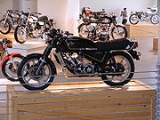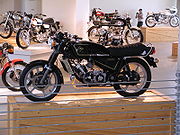
Silk Engineering
Encyclopedia
Silk Engineering was a British motorcycle
manufacturer established by George Silk and Maurice Patey and based at Darley Abbey
, Derbyshire
. They produced Silk 700S
two-stroke motorcycles until 1979. Problems with spare parts and rising costs led to the company ceasing manufacture.
enthusiast who worked for Derbyshire
Scott specialist Tom Ward. George Silk developed a racing motorcycle by fitting a Scott engine into a Spondon frame. Following some success with a Silk Special at the Barbon Hill Climb in 1970, Silk began planning a road-going prototype with his business partner Maurice Patey. They set up Silk Engineering and began providing a spares and repair service for Scott motorcycle owners. They also offered a range of modifications to improve the reliability and performance of Scotts, as well as improving the lubrication and gas flow. Silk exhibited the prototype at the Racing and Sporting Motorcycle Show in London in 1971. Orders exceeded his capability to produce them but he hand-built 21 Silk-Scott Specials between 1971 and 1975. The supply of Scott engines was limited, therefore customers were asked to find their own.
Matt Holder, who had bought the rights to the Scott engines, disputed the use of the Scott trademark and prevented Silk from making Scott engines under licence, forcing Silk to develop his own. A new two stroke engine was developed by David Midgelow (from Rolls Royce
engineering) and George Silk, and they had assistance from two-stroke expert Gordon Blair of Queen’s University, Belfast
, who optimised the porting with the aid of specialist computer programs.
 The Silk 700S
The Silk 700S
was launched in 1975 and featured the new engine in a specially designed steel tubular frame made by Spondon Engineering of Derbyshire, who also made the forks, yolks, disc/drum brakes and rotors. Priced at £1,355 it was the most expensive production motorcycle of the time. The 700S continued to be developed at the Darley Abbey
works in Derbyshire
, along with the SPR Production Racing version. Production was slow, with just two motorcycles a week coming off the production line. Customers could select from five colour schemes – British Racing Green, metallic blue or green, black with gold coachlines or plain red. There was also a Scott special edition in purple and cream – and a special scheme similar to Silk Cut cigarettes, which were popular at the time.
The thermo-syphon cooling system boiled water using engine heat, then fed it back from the radiator in a rubber tube to the engine cases, where it boiled again, removing the need for a water pump.
The Silk Engineering company was taken over by the Kendal
-based Furmanite International Group in 1976 who continued production of the Silk 700S and in 1977 it was upgraded to the 700S Mk2, which Silk called the Sabre. Improvements from the Mk 1 included finned cylinder barrels, a redesigned seat, instruments and rear light nacelle. Porting and timing revisions plus a higher compression boosted power to a more respectable 48hp, but the price continued to rise. In 1978 the 100th Silk motorcycle was produced and production continued until December 1979 when Silk realised they were losing £200 with every motorcycle sold.
magazine.
Motorcycle
A motorcycle is a single-track, two-wheeled motor vehicle. Motorcycles vary considerably depending on the task for which they are designed, such as long distance travel, navigating congested urban traffic, cruising, sport and racing, or off-road conditions.Motorcycles are one of the most...
manufacturer established by George Silk and Maurice Patey and based at Darley Abbey
Darley Abbey
Darley Abbey is a village on the outskirts of Derby, England. The village is located on the River Derwent and is associated with the world heritage site of Derwent Valley Mills.- History :...
, Derbyshire
Derbyshire
Derbyshire is a county in the East Midlands of England. A substantial portion of the Peak District National Park lies within Derbyshire. The northern part of Derbyshire overlaps with the Pennines, a famous chain of hills and mountains. The county contains within its boundary of approx...
. They produced Silk 700S
Silk 700S
The Silk 700S was a British motorcycle made by Silk Engineering between 1975 and 1979 in Darley Abbey, Derbyshire, UK.-Development:The Silk 700S was launched in 1975 and featured a new engine based on the two stroke engine from the Scott Flying Squirrel in a specially designed steel tubular frame...
two-stroke motorcycles until 1979. Problems with spare parts and rising costs led to the company ceasing manufacture.
History
Silk was founded in the late 1960s by George Silk, a Scott motorcycleThe Scott Motorcycle Company
The Scott Motorcycle Company was owned by Scott Motors Limited, Shipley, West Yorkshire, England and was a well known producer of motorcycles and light engines for industry...
enthusiast who worked for Derbyshire
Derbyshire
Derbyshire is a county in the East Midlands of England. A substantial portion of the Peak District National Park lies within Derbyshire. The northern part of Derbyshire overlaps with the Pennines, a famous chain of hills and mountains. The county contains within its boundary of approx...
Scott specialist Tom Ward. George Silk developed a racing motorcycle by fitting a Scott engine into a Spondon frame. Following some success with a Silk Special at the Barbon Hill Climb in 1970, Silk began planning a road-going prototype with his business partner Maurice Patey. They set up Silk Engineering and began providing a spares and repair service for Scott motorcycle owners. They also offered a range of modifications to improve the reliability and performance of Scotts, as well as improving the lubrication and gas flow. Silk exhibited the prototype at the Racing and Sporting Motorcycle Show in London in 1971. Orders exceeded his capability to produce them but he hand-built 21 Silk-Scott Specials between 1971 and 1975. The supply of Scott engines was limited, therefore customers were asked to find their own.
Matt Holder, who had bought the rights to the Scott engines, disputed the use of the Scott trademark and prevented Silk from making Scott engines under licence, forcing Silk to develop his own. A new two stroke engine was developed by David Midgelow (from Rolls Royce
Rolls-Royce Limited
Rolls-Royce Limited was a renowned British car and, from 1914 on, aero-engine manufacturing company founded by Charles Stewart Rolls and Henry Royce on 15 March 1906 as the result of a partnership formed in 1904....
engineering) and George Silk, and they had assistance from two-stroke expert Gordon Blair of Queen’s University, Belfast
Belfast
Belfast is the capital of and largest city in Northern Ireland. By population, it is the 14th biggest city in the United Kingdom and second biggest on the island of Ireland . It is the seat of the devolved government and legislative Northern Ireland Assembly...
, who optimised the porting with the aid of specialist computer programs.
The Silk 700S

Silk 700S
The Silk 700S was a British motorcycle made by Silk Engineering between 1975 and 1979 in Darley Abbey, Derbyshire, UK.-Development:The Silk 700S was launched in 1975 and featured a new engine based on the two stroke engine from the Scott Flying Squirrel in a specially designed steel tubular frame...
was launched in 1975 and featured the new engine in a specially designed steel tubular frame made by Spondon Engineering of Derbyshire, who also made the forks, yolks, disc/drum brakes and rotors. Priced at £1,355 it was the most expensive production motorcycle of the time. The 700S continued to be developed at the Darley Abbey
Darley Abbey
Darley Abbey is a village on the outskirts of Derby, England. The village is located on the River Derwent and is associated with the world heritage site of Derwent Valley Mills.- History :...
works in Derbyshire
Derbyshire
Derbyshire is a county in the East Midlands of England. A substantial portion of the Peak District National Park lies within Derbyshire. The northern part of Derbyshire overlaps with the Pennines, a famous chain of hills and mountains. The county contains within its boundary of approx...
, along with the SPR Production Racing version. Production was slow, with just two motorcycles a week coming off the production line. Customers could select from five colour schemes – British Racing Green, metallic blue or green, black with gold coachlines or plain red. There was also a Scott special edition in purple and cream – and a special scheme similar to Silk Cut cigarettes, which were popular at the time.
The thermo-syphon cooling system boiled water using engine heat, then fed it back from the radiator in a rubber tube to the engine cases, where it boiled again, removing the need for a water pump.
The Silk Engineering company was taken over by the Kendal
Kendal
Kendal, anciently known as Kirkby in Kendal or Kirkby Kendal, is a market town and civil parish within the South Lakeland District of Cumbria, England...
-based Furmanite International Group in 1976 who continued production of the Silk 700S and in 1977 it was upgraded to the 700S Mk2, which Silk called the Sabre. Improvements from the Mk 1 included finned cylinder barrels, a redesigned seat, instruments and rear light nacelle. Porting and timing revisions plus a higher compression boosted power to a more respectable 48hp, but the price continued to rise. In 1978 the 100th Silk motorcycle was produced and production continued until December 1979 when Silk realised they were losing £200 with every motorcycle sold.
Silk 500
The last Silk motorcycle ever built was Clive Worrell's 500 cc model based on a prototype that was never produced. It was used as a competition prize for Classic BikeClassic Bike
Classic Bike is a UK motorcycle magazine. Launched in 1978, it is noted for coverage of all makes of classic motorcycles, including US and Japanese models, and one-off specials. Editor Hugo Wilson, who began riding motorcycles at the age of 11, formerly edited Bike magazine and is the author of...
magazine.

